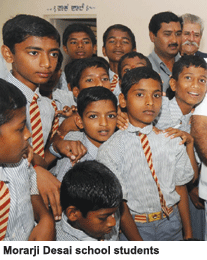One of the defining characteristics of the sputtering Indian education system is to launch enterprises of great pith and moment whose currents are allowed to run awry because of implementation failure. A live example are Karnataka’s 394 Shri Morarji Desai and 114 Rani Chennamma Residential schools, promoted to provide free-of-charge class VI-X education to scheduled caste (SC), scheduled tribe (ST) and other backward caste (OBC) students in the rural hinterland of the state (pop. 59 million).
 Modelled after the Central government-promoted 600 Jawahar Navodaya Vidyalaya rural residential schools, the first Morarji Desai and Rani Chennamma schools were inaugurated with much fanfare by the Congress-led Veerappa Moily government in 1992. Since then, their number has risen to 394 and 114 respectively with an aggregate enrolment of 98,500 students instructed by 4,000 teachers, including 700 ‘contract teachers’.
Modelled after the Central government-promoted 600 Jawahar Navodaya Vidyalaya rural residential schools, the first Morarji Desai and Rani Chennamma schools were inaugurated with much fanfare by the Congress-led Veerappa Moily government in 1992. Since then, their number has risen to 394 and 114 respectively with an aggregate enrolment of 98,500 students instructed by 4,000 teachers, including 700 ‘contract teachers’.
That despite a plethora of politically correct legislation, SC, ST and OBC children (and adults) continue to suffer routine and cruel discrimination at the hands of upper caste Hindus in rural — especially village — India is a social reality which few apart from politicians bother to deny. Therefore it made good sense — and excellent vote-bank politics — to establish all-found residential secondary (class VI-XII) schools for their brightest and best children. But after they were constructed at approximately Rs.2 crore each, successive state governments have neglected — rather than celebrated — these secondary schools.
Last month on May 5, these state government-funded schools were once again in the spotlight when over 700 ‘contract teachers/principals’ and non-teaching staff staged a protest rally before the Town Hall in Bangalore demanding “immediate regularisation of their services” and withdrawal of a government order calling for applications for new ‘permanent teachers’ positions’ in the Morarji Desai and Rani Chennamma schools. The recruitment order dated April 27 directs all new applicants and the 700-plus contract teachers/principals to write a competitive examination to be held on July 24-27, in which in-service contract teachers will be given a weightage of five marks.
Since promulgation of the order, the 700-plus contract teachers represented by the Karnataka Rajya Samyukta Naukarara Sangha (KRSNS) have been up in arms against the state government. Their contention is that they have been appointed after clearing the govern-ment’s recruitment procedure and it’s unfair to put them through the grind again. According to B. Thippeswamy, district convener of the KRSNS, the new recruitment order will jeopardise the careers of thousands of contract teachers. “I urge the government to regularise the services of contract teachers and withdraw the recruitment order with immediate effect,” Thippeswamy told mediapersons at the protest rally.
Certainly contract teachers have a legitimate grievance. For over 12 years, their remuneration has been half of permanent teachers doing the same work in the very same schools. They are paid a mere Rs.6,500 per month against Rs.13,000 paid to permanent teachers. Likewise, permanent principals are paid Rs.16,000 while those on contract receive Rs.8,000. Moreover during the April-May summer vacation, contract teachers and principals don’t get paid at all.
The root cause of this more than decade-old problem of contract teachers is the inadequate budgetary provision made for these high-potential second-aries. The annual grant sanctioned for the 394 Morarji Desai schools is a meagre Rs.120 crore (i.e Rs.31 lakh per school and Rs.12,000 per student per year) — totally inadequate to fund teacher salaries and students’ tuition, food and lodging of the 98,500 brightest and best SC, ST and OBC children enroled in these schools.
This short-sighted neglect of the Morarji Desai and Rani Chennamma schools is surprising because they are star performers among Karnataka’s 3,029 government secondary schools. In 2009-10 Morarji Desai schools recorded a pass percentage of 90 in the state govern-ment’s State Secondary Leaving Certificate (SSLC) class X board exam — cf. 84.48 percent in private unaided schools and 75.38 percent in govern-ment schools.
Prof. A.S. Seetharamu, former professor of education at the Institute of Social and Economic Change, Banga-lore and education advisor to the Karnataka government, attributes this excellent performance to the schools’ high-quality students. “This is a very successful initiative for upliftment of SC and ST children served by proven teachers. Therefore the state govern-ment must adequately fund these high-potential schools so they don’t have to hire contract teachers. The contract teachers’ agitation, although justified, is endangering these excellent and succ-essful institutions,” warns Seetharamu.
A timely, indeed overdue warning, which Karnataka’s warring politicians stewed in corruption, are unlikely to heed.
Swati Roy (Bangalore)